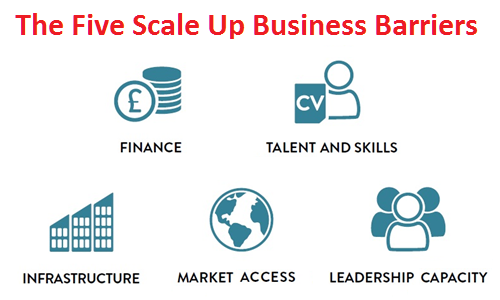UK scale up businesses, most between £10m and £40m turnover, are growing at over 20% a year.
Scale up business numbers are doing well, growing by 12% YOY from 31,440 to 35,201 (ONS data 2016).
Whilst scale ups represents just one percent of all UK businesses, only one percent more UK scale up businesses would create an extra 238,000 jobs and add £225bn in GVA (Scaleup Institute report on UK Economic Growth 2014).
Many scale ups are growing at rates of 50% a year and higher, and this creates all manner of challenges to continue further successful growth. Factors like staff recruitment and access to skills, growth funding, local infrastructure and export markets.
There is clearly lots to do to break down the barriers scale ups face. Local and government funded organisations are now aiming to ensure scale ups are a national priority, get them embedded into the local fabric of the communities in which they operate, and deliver scale up business support solutions across both the private and public sector.
Start Ups versus Scale Up Businesses
A start up is often defined by its main challenge, a search for a repeatable and scalable business model. A start up becomes a scale up after it has validated its business model hypothesis, solved all of the many start up challenges, like seed funding and skills for development, and is ready for growth. This stage of growth, often almost exponential growth, is called ‘crossing the growth chasm’, a phrase originating from marketing guru Geoffrey Moore in 1991.
The reason start ups are important to the UK is that without a vibrant start up community it is difficult to get to the point where you have enough companies to then go on to scale up. Every healthy country economy needs a pool of local start ups that naturally lead on to scale ups, as the latter exist on top of a solid start up ‘ecosystem’.
In order to flourish, a scale up business requires a solid pool of established companies interested in providing growth opportunities. The World Economic Forum assesses the expansion challenges affecting these types of business, and stresses the importance of the scale-up phase directly after the start-up phase.
What is a scale up business?
So when does your start up become a scale up? A Scale Up is a company who has an average annual increase in turnover of at least 20% over the past three years, and who has at least ten employees at the start of the period (OECD 2007).
Scale Ups that are visible can be ascertained due to that fact that all UK companies are required to disclose their turnover if two out of the three following conditions are true:
- Annual turnover exceeds £10.2m
- Business assets exceed £5.1m
- More than 50 employees
So defining which UK businesses are scale ups is easy, right? Well unfortunately not. Whilst there are clear criteria for a scale up, based on size, numbers of staff and growth by turnover, not all scale ups are currently visible.
Only if a business has a turnover of just over ten million can it be revealed if they are growing at the defined 20% rate, unless those companies that are smaller also choose to declare their turnover. So there is actually an as yet unknown pool of ‘invisible’ scale ups that may already be growing at a rate of 20% or greater, with less than ten million in turnover, less than 50 staff, or business assets under five million pounds.
UK Government focus on Scale Ups
The 2017 UK Government Industrial Strategy White Paper focused on the value of scale ups and recognised them as part of the overall solution to UK productivity challenges across all industry sectors.
Whilst the white paper took forward areas of recommendations originally made by the ScaleUp Institute via joint reviews, and the background work of the Scaleup Taskforce, it confirmed the critical importance to UK Scale Ups of R&D funding, skills, access to finance and infrastructure. It frames the importance of people, location, business and technology infrastructure and business environment for the future growth of these critical businesses.
Exports are also key for UK government, piloting intensive export growth support for potential scale-ups and ambitious medium sized businesses. This now includes co-investment to access commercial export support services, with each eligible business offered a grant on a 50:50 match funded basis. Local Enterprise Partnership Growth Hubs are also working to ensure scale ups receive easily accessible and ‘joined up’ export and business growth advice.
Why are scale ups so important?
Evidence from a variety of sources shows scale up businesses are across all industry sectors, and that they generate more productive jobs than the average, with around £235,000 of turnover for each business per employee. They also provide employment opportunities for all local people across a varied spectrum, from work experience to apprenticeships, and from graduates to non-executive directorships.
Despite what you might imagine, many successful scale ups are not ‘techie’ businesses. In fact the majority of scale ups are ‘non-tech’, companies that are successfully using technology but usually not creating it themselves.
Many scale ups are also more than 20 years old, with only a third younger than 10 years old. This indicates that many of the UK’s older and more stable companies clearly have the potential for growth, although data shows they are most likely to be growing at a moderate pace of around 20 to 40% per annum.
The UK’s total number of scale up businesses that increased their turnover and/or staff numbers annually by over 20 percent over a three-year period has increased by 12%.
However, when differentiating between types of scale up business, two distinct patterns emerge:
- An increase in overall scale ups growing by turnover
- Small decrease in scale ups growing by employees
- Only 20% are growing against both measures
Local leaders from the public and private sector are continuing to build on existing schemes to help UK scale ups. Many of the original schemes were galvanised by the Scaleup Institute education programme on ‘Driving Economic Growth through ‘scale up ecosystems’, supported by Goldman Sachs’ 10,000 Small Businesses UK and Innovate UK.
These initial programmes did set multiple scale up projects in motion, working to develop tailored initiatives for scale up business leaders. In turn this led to inclusion of scale ups in local Strategic Economic Plans through local authorities and the 38 Local Enterprise Partnerships (LEPs) in England set up by the Department for Business Innovation and Skills (BIS), as well as the three national LEPs in Scotland, Wales and Northern Ireland.
What scale up businesses want
Scale Ups have indicated that, to continue to grow successfully, they need solutions to five common challenges:
- Access to talent and skills – finding and recruiting the employees to hire who have the skills they need
- Access to new markets – new UK customers and navigating the best ways to access export markets
- Leadership capacity – improving the breadth, knowledge and skills of the key people in the business
- Finance – accessing the right type and combination of affordable finance to help effective growth
- Infrastructure – including premises, space, warehousing and local and technology infrastructure
Many ambitious scale up leaders want to scale more and where they need most help is on talent, access to markets and leadership. People with the right skills remain their top priority, and access to talent the greatest hindrance.
Whether they are recruiting new employees, tapping into the experience of business mentors or Non-Executive Director, who have successfully grown businesses, people are top of mind of scale up leaders to continue to deliver rapid year-on-year growth. This includes building out leadership capacity and seeking the skills needed to expand their global aspirations, including finding international talent.
Not surprisingly, scale up business leaders most value locally-rooted resources to foster their growth, with local solutions tailored to their needs and peer-to-peer networks and events where they can meet their counterparts.
They also see the importance of and seek easier access and deep connections with local educations and university research facilities, collaboration partners, local authorities, other businesses and government agencies.
The importance of financial support is also key. Scale up companies receiving equity investment are more likely to grow their turnover faster, Basically, the more equity investment they receive, the faster they grow. The majority of scale ups that have received finance raised less than £5m. It is an obvious conclusion that if investors had deeper pockets to give the companies more investment, this would enable scale ups to grow faster.
Key scale up challenges
Over half of the Scale Up businesses in a Scaleup Institute 2017 survey perceived no relevant support existing for them, a situation that needs to be remedied urgently. While scale up business leaders did recognise that there are national Government initiatives, they said that they were not always immediately visible, and they want these initiatives delivered locally, in a manner much easier to navigate and access as and when they are required.
There is a great deal of education required at government, local authority, LEP, county Chamber and local business level. An integrated local scale up ecosystem needs to be created and fostered, a support structure regarded as ‘match fit’ for scaling businesses at every stage of their growth journey.
Part of the challenge is showing local businesses that their challenges are already well understood, and improving awareness of immediate solutions that are available to help their growth. This will require good scale up business case studies and success stories and local events and networking groups, to highlight well-evidenced, impactful programmes and practices from which scale up business owners and leaders can learn, emulate and improve.
Also, without a coordinated database of Scale Up businesses and key leadership contacts within them, the resources these businesses require may simply not get to where they are needed most. Broad advertising to them may help, but one to one contact with scale up business owners and leaders is likely to have the greatest long term impact.
Many organisations are already contacting scale ups directly to offer their help and support, by mail, email, phone and through various social media channels. However, there are now multiple data handling considerations to consider in a direct contact approach, including storage and broadcast of personal data. All of these data issues will need managing very carefully, in order to avoid falling foul of UK data protection and new EU GDPR legislation.
Conclusions
Better knowledge of what scale ups really need is urgently required. This includes local scale up business research, analysis, policy and data, ultimately to make sure that the limited funds available to scale ups are used in the best way possible to their current challenges and future expansion.
Scale ups are twice as likely as their peers to be centres of innovation in the UK, but research shows they are keen to see better access to R&D innovation funding and growth finance options delivered locally, along with access to the infrastructure that supports their innovation drive. Better local access to staff, new customer and export markets and improvement in leadership skills also remain critical components to future UK scale up business success.
Local businesses that meet the Scale Up definition and criteria should recognise that there are resources, skills and advice available to them now, to help them expand and grow further. LEPs all get a share of UK government funding to generate business growth, allocated through competitive bidding. These funds, as well as LEP staff, local growth hubs and local growth partners can help scale up businesses in all sectors to achieve their full growth potential.
GET Consultants is holding a series of Scale Up Labs to help High Growth Small Businesses to transform and grow and avoid some of the pitfalls and barriers to long term and efficient growth. Click for details





